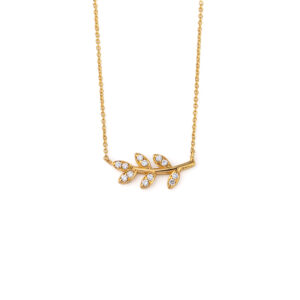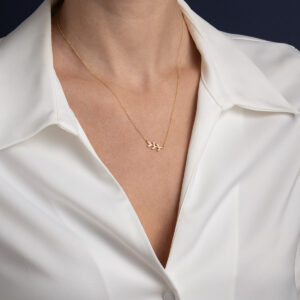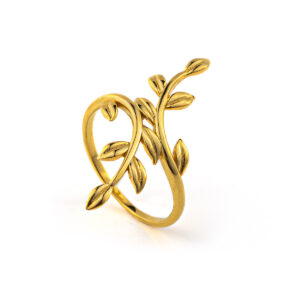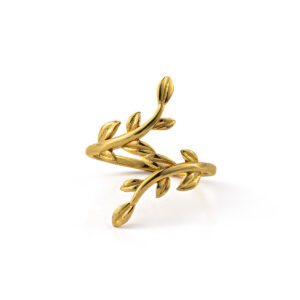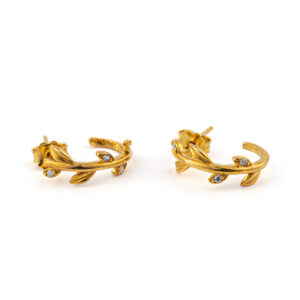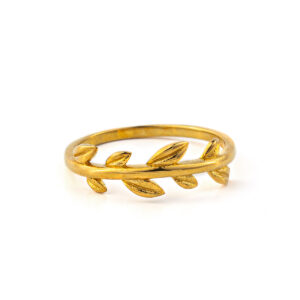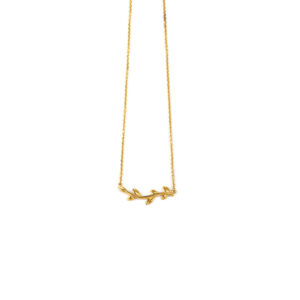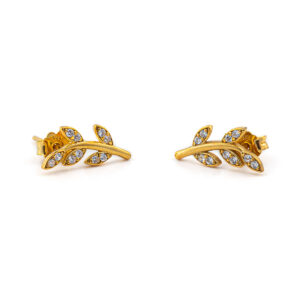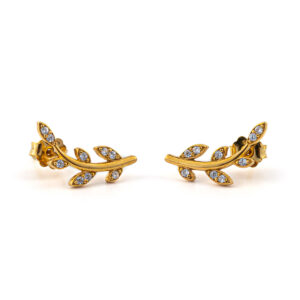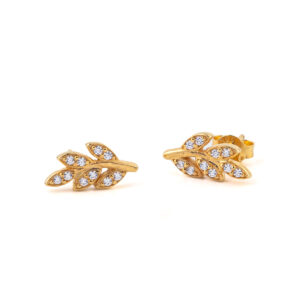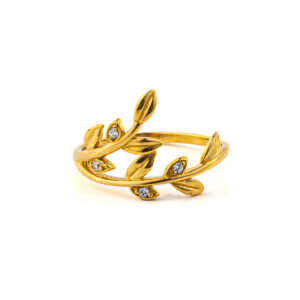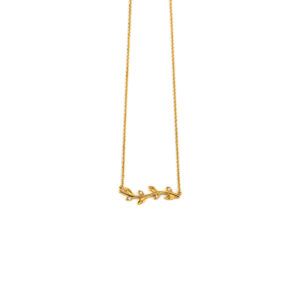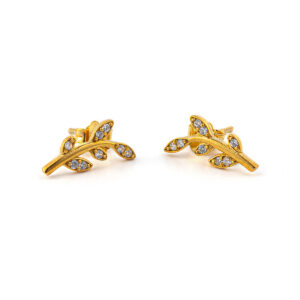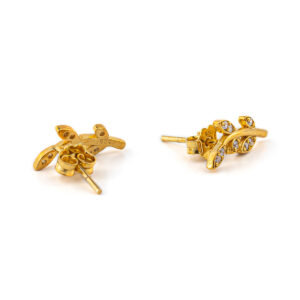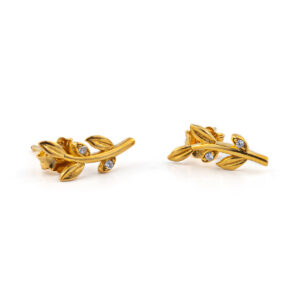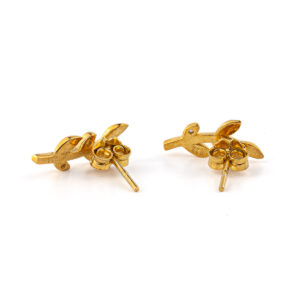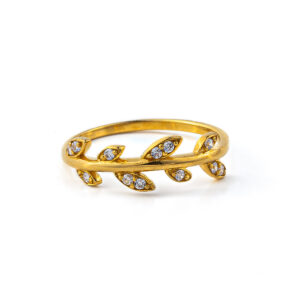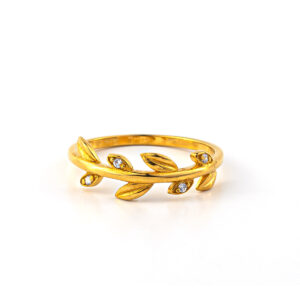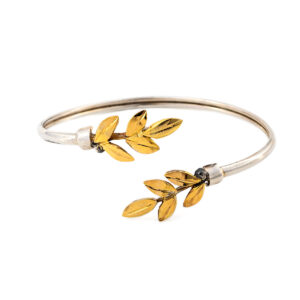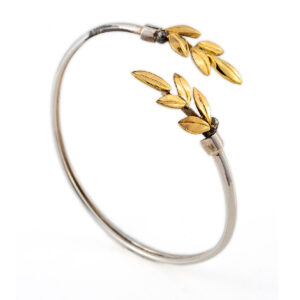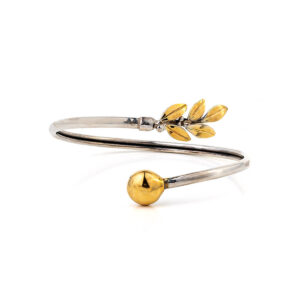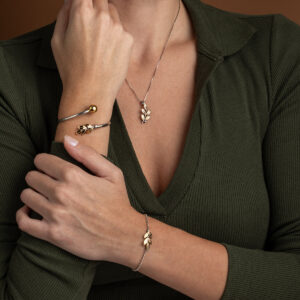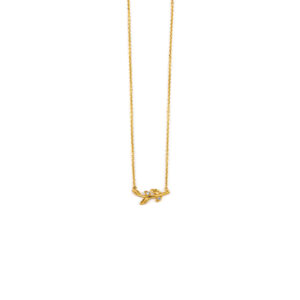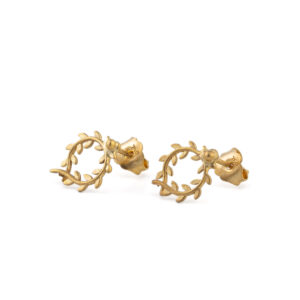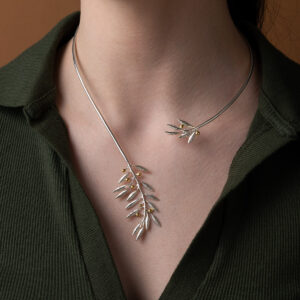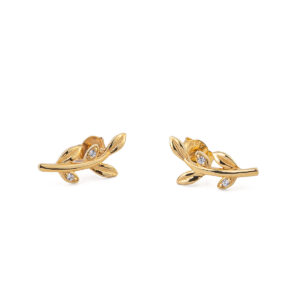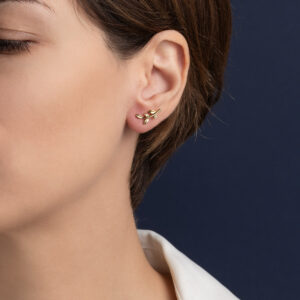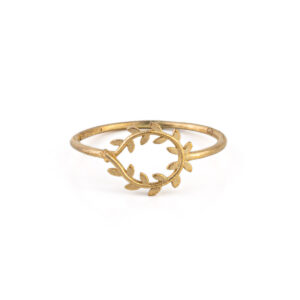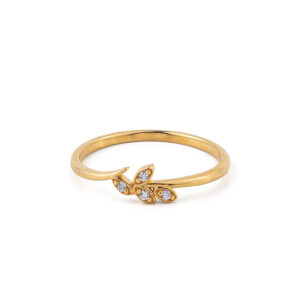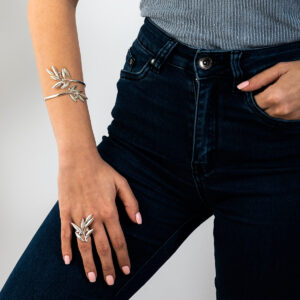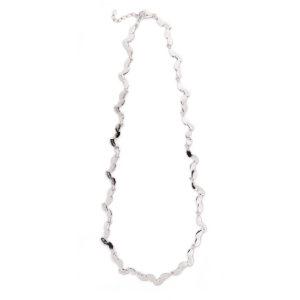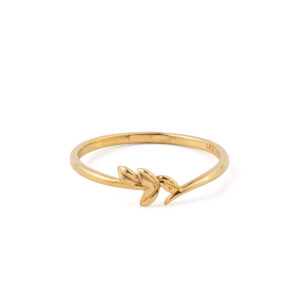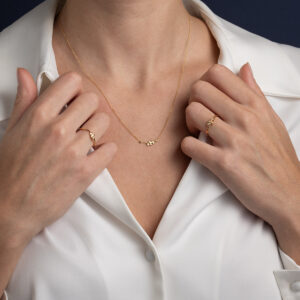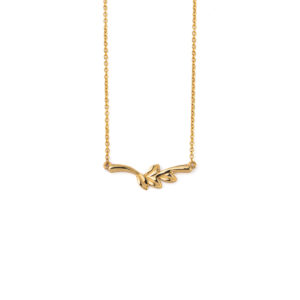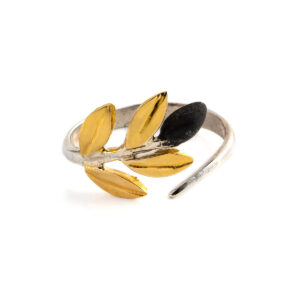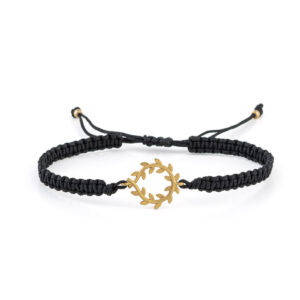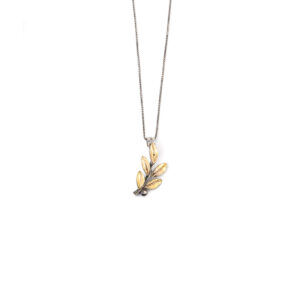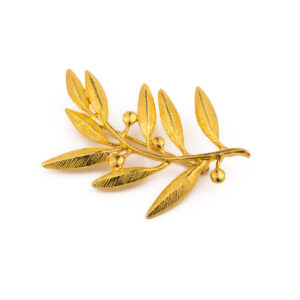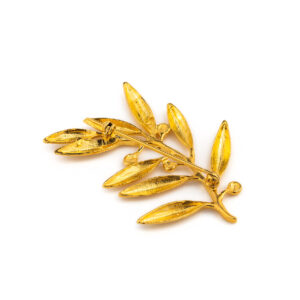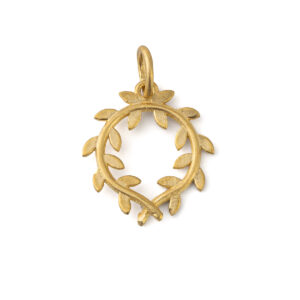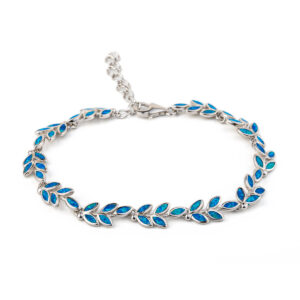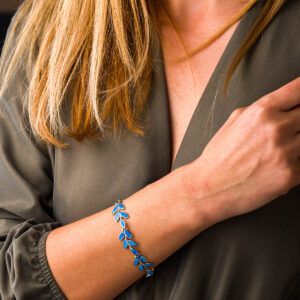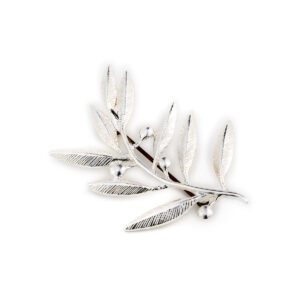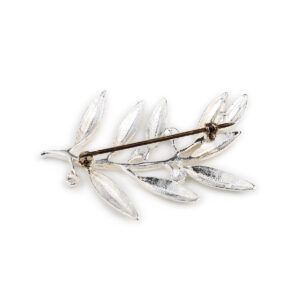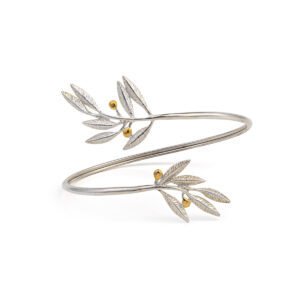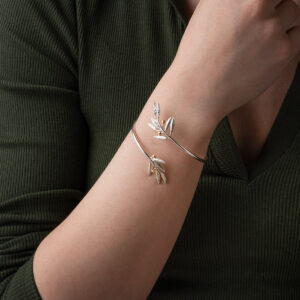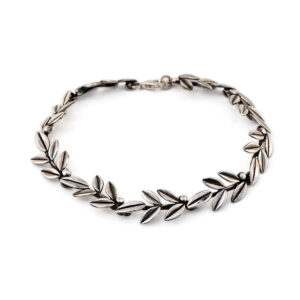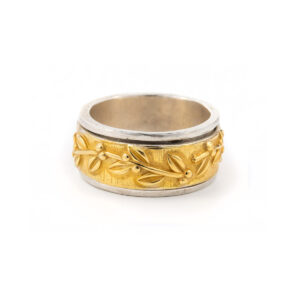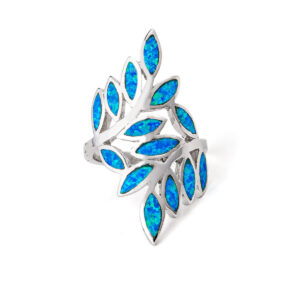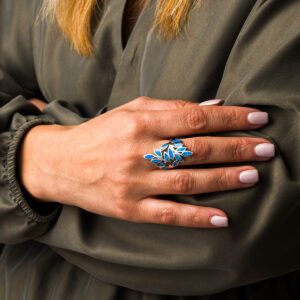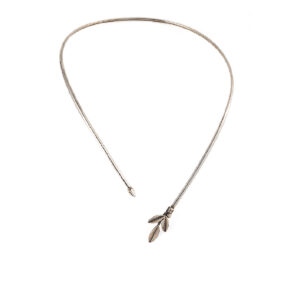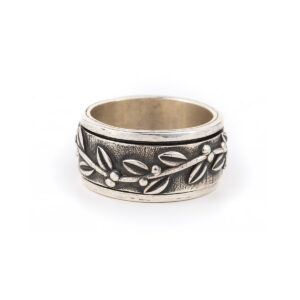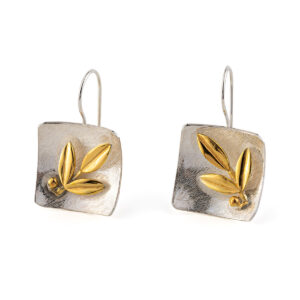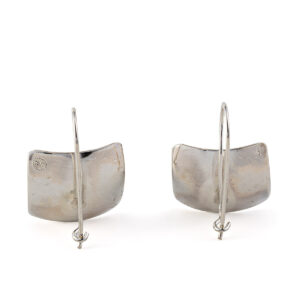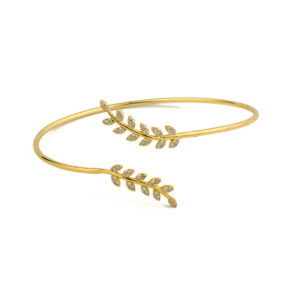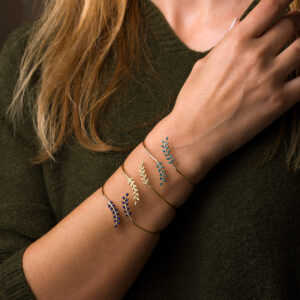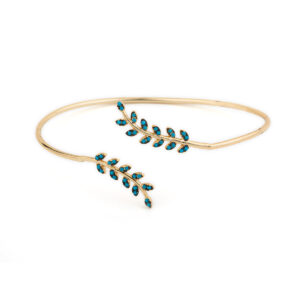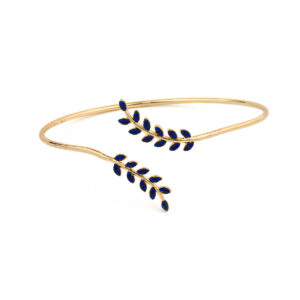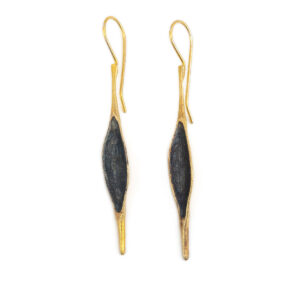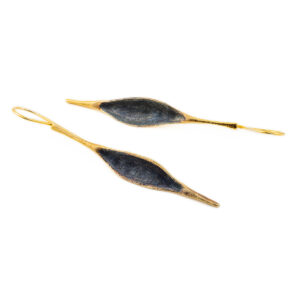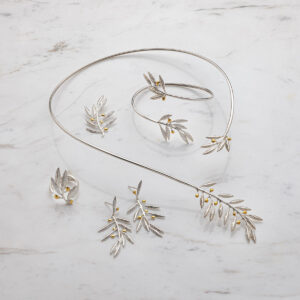Η συλλογή μας Ελιά, είναι εμπνευσμένη από την αρχαία ελληνική ιστορία και ιδιαίτερα από την ελληνική γη. Περιλαμβάνει μοναδικά χειροποίητα κοσμήματα, σκουλαρίκια, δαχτυλίδια, βραχιόλια, καρφίτσες με φύλλα ελιάς και πολύτιμους λίθους σε Ασήμι ή Χρυσό. Η ελιά στην Αρχαία Ελλάδα ήταν σύμβολο του Ολυμπιακού ιδεώδους, αφού ένα κλαδί ελιάς ήταν το μοναδικό έπαθλο για τους Ολυμπιονίκες. Η ελιά συμβολίζει την ειρήνη, τη νίκη, την τιμή και την ευημερία.
Κολιέ Φύλλο Ελιάς με Ζιργκόν – Χρυσό 18Κ
745,00€Βραχιόλι εμπνευσμένο από το σύμβολο του φύλλου της ελιάς.
Από χρυσό 18 καρατίων με ζιργκόν.
Το στεφάνι ελιάς, γνωστό και ως κότινο, ήταν το βραβείο για τον νικητή στους αρχαίους Ολυμπιακούς Αγώνες. Ήταν ένα κλαδί ελιάς, από την αγριελιά που φύτρωνε στην Ολυμπία,πλεγμένο σε κύκλο ή πέταλο. Σύμφωνα με τον Παυσανία εισήχθη από τον Ηρακλή ως έπαθλο για τον νικητή του αγώνα δρόμου προς τιμήν του πατέρα του Δία. Στους αρχαίους Ολυμπιακούς Αγώνες δεν υπήρχαν χρυσά, ασημένια ή χάλκινα μετάλλια. Υπήρχε μόνο ένας νικητής ανά αγώνισμα, ο οποίος στεφανωνόταν με ένα στεφάνι ελιάς από φύλλα αγριελιάς από ένα ιερό δέντρο κοντά στο ναό του Δία στην Ολυμπία. Στεφάνια ελιάς μοιράστηκαν κατά τη διάρκεια των θερινών Ολυμπιακών Αγώνων του 2004 στην Αθήνα προς τιμήν της αρχαίας παράδοσης, επειδή οι αγώνες διεξάγονταν στην Ελλάδα.
Χειροποίητο Ελληνικό Κόσμημα
Ανακαλύψτε τη Συλλογή Ελιά
Δαχτυλίδι Κλαδί – 18Κ Χρυσό
630,00€Ring inspired by the olive leaf symbol.
Made of 18k gold.
The olive wreath also known as kotinos was the prize for the winner at the ancient Olympic Games. It was an olive branch, of the wild- olive tree that grew at Olympia,intertwined to form a circle or a horse-shoe. According to Pausanias it was introduced by Heracles as a prize for the running race winner to honour his father Zeus. In the ancient Olympic Games there were no gold, silver, or bronze medals. There was only one winner per event, crowned with an olive wreath made of wild-olive leaves from a sacred tree near the temple of Zeus at Olympia. Olive wreaths were given out during the 2004 Summer Olympics in Athens in honor of the ancient tradition, because the games were being held in Greece.
Δαχτυλίδι Κλαδί – 18Κ Χρυσό
567,00€Ring inspired by the olive leaf symbol.
Made of 18k gold.
The olive wreath also known as kotinos was the prize for the winner at the ancient Olympic Games. It was an olive branch, of the wild- olive tree that grew at Olympia,intertwined to form a circle or a horse-shoe. According to Pausanias it was introduced by Heracles as a prize for the running race winner to honour his father Zeus. In the ancient Olympic Games there were no gold, silver, or bronze medals. There was only one winner per event, crowned with an olive wreath made of wild-olive leaves from a sacred tree near the temple of Zeus at Olympia. Olive wreaths were given out during the 2004 Summer Olympics in Athens in honor of the ancient tradition, because the games were being held in Greece.
Σκουλαρίκια Κλαδί – 14Κ Χρυσό με Ζιργκόν
492,00€Earrings inspired by the olive leaf symbol.
Made of 14k gold with zircon.
The olive wreath also known as kotinos was the prize for the winner at the ancient Olympic Games. It was an olive branch, of the wild- olive tree that grew at Olympia,intertwined to form a circle or a horse-shoe. According to Pausanias it was introduced by Heracles as a prize for the running race winner to honour his father Zeus. In the ancient Olympic Games there were no gold, silver, or bronze medals. There was only one winner per event, crowned with an olive wreath made of wild-olive leaves from a sacred tree near the temple of Zeus at Olympia. Olive wreaths were given out during the 2004 Summer Olympics in Athens in honor of the ancient tradition, because the games were being held in Greece.
Δαχτυλίδι Κλαδί – 14Κ Χρυσό με Ζιργκόν
476,00€Ring inspired by the olive leaf symbol.
Made of 14k gold with zircon.
The olive wreath also known as kotinos was the prize for the winner at the ancient Olympic Games. It was an olive branch, of the wild- olive tree that grew at Olympia,intertwined to form a circle or a horse-shoe. According to Pausanias it was introduced by Heracles as a prize for the running race winner to honour his father Zeus. In the ancient Olympic Games there were no gold, silver, or bronze medals. There was only one winner per event, crowned with an olive wreath made of wild-olive leaves from a sacred tree near the temple of Zeus at Olympia. Olive wreaths were given out during the 2004 Summer Olympics in Athens in honor of the ancient tradition, because the games were being held in Greece.
Δαχτυλίδι Κλαδί – 14Κ Χρυσό με Ζιργκόν
476,00€Ring inspired by the olive leaf symbol.
Made of 14k gold with zircon.
The olive wreath also known as kotinos was the prize for the winner at the ancient Olympic Games. It was an olive branch, of the wild- olive tree that grew at Olympia,intertwined to form a circle or a horse-shoe. According to Pausanias it was introduced by Heracles as a prize for the running race winner to honour his father Zeus. In the ancient Olympic Games there were no gold, silver, or bronze medals. There was only one winner per event, crowned with an olive wreath made of wild-olive leaves from a sacred tree near the temple of Zeus at Olympia. Olive wreaths were given out during the 2004 Summer Olympics in Athens in honor of the ancient tradition, because the games were being held in Greece.
Δαχτυλίδι Κλαδί – 18Κ Χρυσό
460,00€Ring inspired by the olive leaf symbol.
Made of 18k gold.
The olive wreath also known as kotinos was the prize for the winner at the ancient Olympic Games. It was an olive branch, of the wild- olive tree that grew at Olympia,intertwined to form a circle or a horse-shoe. According to Pausanias it was introduced by Heracles as a prize for the running race winner to honour his father Zeus. In the ancient Olympic Games there were no gold, silver, or bronze medals. There was only one winner per event, crowned with an olive wreath made of wild-olive leaves from a sacred tree near the temple of Zeus at Olympia. Olive wreaths were given out during the 2004 Summer Olympics in Athens in honor of the ancient tradition, because the games were being held in Greece.
Κολιέ Κλαδί – 18Κ Χρυσό με Διαμάντια
460,00€Made of 18K gold.
A necklace inspired from the olive branch, a symbol of peace, abundance and achievement.
Handmade item.
Ancient Greek bracelet with olive leaves – Sterling Silver
Bracelet with olive leaves.
The olive tree in Ancient Greece was a symbol of the Olympic ideal, since an olive branch was the only prize for the Olympic champions. The olive symbolizes peace, victory, honor and prosperity.
Available in silver and gold-plated.
Made of 925⁰ sterling silver.
This bracelet is adjustable.
Σκουλαρίκια Κλαδί – 14Κ Χρυσό με Ζιργκόν
459,00€Earrings inspired by the olive leaf symbol.
Made of 14k gold with zircon.
The olive wreath also known as kotinos was the prize for the winner at the ancient Olympic Games. It was an olive branch, of the wild- olive tree that grew at Olympia,intertwined to form a circle or a horse-shoe. According to Pausanias it was introduced by Heracles as a prize for the running race winner to honour his father Zeus. In the ancient Olympic Games there were no gold, silver, or bronze medals. There was only one winner per event, crowned with an olive wreath made of wild-olive leaves from a sacred tree near the temple of Zeus at Olympia. Olive wreaths were given out during the 2004 Summer Olympics in Athens in honor of the ancient tradition, because the games were being held in Greece.
Δαχτυλίδι Κλαδί – 14Κ Χρυσό με Ζιργκόν
459,00€Ring inspired by the olive leaf symbol.
Made of 14k gold with zircon.
The olive wreath also known as kotinos was the prize for the winner at the ancient Olympic Games. It was an olive branch, of the wild- olive tree that grew at Olympia,intertwined to form a circle or a horse-shoe. According to Pausanias it was introduced by Heracles as a prize for the running race winner to honour his father Zeus. In the ancient Olympic Games there were no gold, silver, or bronze medals. There was only one winner per event, crowned with an olive wreath made of wild-olive leaves from a sacred tree near the temple of Zeus at Olympia. Olive wreaths were given out during the 2004 Summer Olympics in Athens in honor of the ancient tradition, because the games were being held in Greece.
Δαχτυλίδι Κλαδί – 14Κ Χρυσό
440,00€Ring inspired by the olive leaf symbol.
Made of 14k gold.
The olive wreath also known as kotinos was the prize for the winner at the ancient Olympic Games. It was an olive branch, of the wild- olive tree that grew at Olympia,intertwined to form a circle or a horse-shoe. According to Pausanias it was introduced by Heracles as a prize for the running race winner to honour his father Zeus. In the ancient Olympic Games there were no gold, silver, or bronze medals. There was only one winner per event, crowned with an olive wreath made of wild-olive leaves from a sacred tree near the temple of Zeus at Olympia. Olive wreaths were given out during the 2004 Summer Olympics in Athens in honor of the ancient tradition, because the games were being held in Greece.
Σκουλαρίκια Κλαδί – 14Κ Χρυσό με Ζιργκόν
408,00€Earrings inspired by the olive leaf symbol.
Made of 14k gold with zircon.
The olive wreath also known as kotinos was the prize for the winner at the ancient Olympic Games. It was an olive branch, of the wild- olive tree that grew at Olympia,intertwined to form a circle or a horse-shoe. According to Pausanias it was introduced by Heracles as a prize for the running race winner to honour his father Zeus. In the ancient Olympic Games there were no gold, silver, or bronze medals. There was only one winner per event, crowned with an olive wreath made of wild-olive leaves from a sacred tree near the temple of Zeus at Olympia. Olive wreaths were given out during the 2004 Summer Olympics in Athens in honor of the ancient tradition, because the games were being held in Greece.
Δαχτυλίδι Κλαδί – 14Κ Χρυσό με Ζιργκόν
408,00€Ring inspired by the olive leaf symbol.
Made of 14k gold with zircon.
The olive wreath also known as kotinos was the prize for the winner at the ancient Olympic Games. It was an olive branch, of the wild- olive tree that grew at Olympia,intertwined to form a circle or a horse-shoe. According to Pausanias it was introduced by Heracles as a prize for the running race winner to honour his father Zeus. In the ancient Olympic Games there were no gold, silver, or bronze medals. There was only one winner per event, crowned with an olive wreath made of wild-olive leaves from a sacred tree near the temple of Zeus at Olympia. Olive wreaths were given out during the 2004 Summer Olympics in Athens in honor of the ancient tradition, because the games were being held in Greece.
Δαχτυλίδι Κλαδί – 14Κ Χρυσό
408,00€Ring inspired by the olive leaf symbol.
Made of 14k gold.
The olive wreath also known as kotinos was the prize for the winner at the ancient Olympic Games. It was an olive branch, of the wild- olive tree that grew at Olympia,intertwined to form a circle or a horse-shoe. According to Pausanias it was introduced by Heracles as a prize for the running race winner to honour his father Zeus. In the ancient Olympic Games there were no gold, silver, or bronze medals. There was only one winner per event, crowned with an olive wreath made of wild-olive leaves from a sacred tree near the temple of Zeus at Olympia. Olive wreaths were given out during the 2004 Summer Olympics in Athens in honor of the ancient tradition, because the games were being held in Greece.
Σκουλαρίκια Φύλλα Ελιάς με Ζιργκόν – Χρυσό 14Κ
390,00€Σκουλαρίκια εμπνευσμένα από το σύμβολο του φύλλου της ελιάς.
Από χρυσό 14 καρατίων με ζιργκόν.
Το στεφάνι ελιάς, γνωστό και ως κότινο, ήταν το βραβείο για τον νικητή στους αρχαίους Ολυμπιακούς Αγώνες. Ήταν ένα κλαδί ελιάς, από την αγριελιά που φύτρωνε στην Ολυμπία, πλεγμένο σε κύκλο ή πέταλο. Σύμφωνα με τον Παυσανία εισήχθη από τον Ηρακλή ως έπαθλο για τον νικητή του αγώνα δρόμου προς τιμήν του πατέρα του Δία. Στους αρχαίους Ολυμπιακούς Αγώνες δεν υπήρχαν χρυσά, ασημένια ή χάλκινα μετάλλια. Υπήρχε μόνο ένας νικητής ανά αγώνισμα, ο οποίος στεφανωνόταν με ένα στεφάνι ελιάς από φύλλα αγριελιάς από ένα ιερό δέντρο κοντά στο ναό του Δία στην Ολυμπία. Στεφάνια ελιάς μοιράστηκαν κατά τη διάρκεια των θερινών Ολυμπιακών Αγώνων του 2004 στην Αθήνα προς τιμήν της αρχαίας παράδοσης, επειδή οι αγώνες διεξάγονταν στην Ελλάδα.
Χειροποίητο Ελληνικό Κόσμημα
Ανακαλύψτε τη Συλλογή Ελιά
Δαχτυλίδι Κλαδί – 14Κ Χρυσό με Ζιργκόν
390,00€Ring inspired by the olive leaf symbol.
Made of 14k gold with zircon.
The olive wreath also known as kotinos was the prize for the winner at the ancient Olympic Games. It was an olive branch, of the wild- olive tree that grew at Olympia,intertwined to form a circle or a horse-shoe. According to Pausanias it was introduced by Heracles as a prize for the running race winner to honour his father Zeus. In the ancient Olympic Games there were no gold, silver, or bronze medals. There was only one winner per event, crowned with an olive wreath made of wild-olive leaves from a sacred tree near the temple of Zeus at Olympia. Olive wreaths were given out during the 2004 Summer Olympics in Athens in honor of the ancient tradition, because the games were being held in Greece.
Κολιέ Κλαδί – 14Κ Χρυσό με Ζιργκόν
390,00€Made in 14K gold with zircon.
A necklace inspired from the olive branch, a symbol of peace, abundance and achievement.
Handmade item.
Κολιέ Κλαδί – 14Κ Χρυσό με Ζιργκόν
390,00€Made in 14K gold with zircon.
A necklace inspired from the olive branch, a symbol of peace, abundance and achievement.
Handmade item.
Σκουλαρίκια Κλαδί – 14Κ Χρυσό με Ζιργκόν
340,00€Earrings inspired by the olive leaf symbol.
Made of 14k gold with zircon.
The olive wreath also known as kotinos was the prize for the winner at the ancient Olympic Games. It was an olive branch, of the wild- olive tree that grew at Olympia,intertwined to form a circle or a horse-shoe. According to Pausanias it was introduced by Heracles as a prize for the running race winner to honour his father Zeus. In the ancient Olympic Games there were no gold, silver, or bronze medals. There was only one winner per event, crowned with an olive wreath made of wild-olive leaves from a sacred tree near the temple of Zeus at Olympia. Olive wreaths were given out during the 2004 Summer Olympics in Athens in honor of the ancient tradition, because the games were being held in Greece.
Σκουλαρίκια Κλαδί – 14Κ Χρυσό με Ζιργκόν
340,00€Earrings inspired by the olive leaf symbol.
Made of 14k gold with zircon.
The olive wreath also known as kotinos was the prize for the winner at the ancient Olympic Games. It was an olive branch, of the wild- olive tree that grew at Olympia,intertwined to form a circle or a horse-shoe. According to Pausanias it was introduced by Heracles as a prize for the running race winner to honour his father Zeus. In the ancient Olympic Games there were no gold, silver, or bronze medals. There was only one winner per event, crowned with an olive wreath made of wild-olive leaves from a sacred tree near the temple of Zeus at Olympia. Olive wreaths were given out during the 2004 Summer Olympics in Athens in honor of the ancient tradition, because the games were being held in Greece.
Δαχτυλίδι Κλαδί – 14Κ Χρυσό
323,00€Ring inspired by the olive leaf symbol.
Made of 14k gold.
The olive wreath also known as kotinos was the prize for the winner at the ancient Olympic Games. It was an olive branch, of the wild- olive tree that grew at Olympia,intertwined to form a circle or a horse-shoe. According to Pausanias it was introduced by Heracles as a prize for the running race winner to honour his father Zeus. In the ancient Olympic Games there were no gold, silver, or bronze medals. There was only one winner per event, crowned with an olive wreath made of wild-olive leaves from a sacred tree near the temple of Zeus at Olympia. Olive wreaths were given out during the 2004 Summer Olympics in Athens in honor of the ancient tradition, because the games were being held in Greece.
Δαχτυλίδι Κλαδί – 14Κ Χρυσό με Ζιργκόν
323,00€Ring inspired by the olive leaf symbol.
Made of 14k gold with zircon.
The olive wreath also known as kotinos was the prize for the winner at the ancient Olympic Games. It was an olive branch, of the wild- olive tree that grew at Olympia,intertwined to form a circle or a horse-shoe. According to Pausanias it was introduced by Heracles as a prize for the running race winner to honour his father Zeus. In the ancient Olympic Games there were no gold, silver, or bronze medals. There was only one winner per event, crowned with an olive wreath made of wild-olive leaves from a sacred tree near the temple of Zeus at Olympia. Olive wreaths were given out during the 2004 Summer Olympics in Athens in honor of the ancient tradition, because the games were being held in Greece.
Δαχτυλίδι Κλαδί – 14Κ Χρυσό με Ζιργκόν
323,00€Ring inspired by the olive leaf symbol.
Made of 14k gold with zircon.
The olive wreath also known as kotinos was the prize for the winner at the ancient Olympic Games. It was an olive branch, of the wild- olive tree that grew at Olympia,intertwined to form a circle or a horse-shoe. According to Pausanias it was introduced by Heracles as a prize for the running race winner to honour his father Zeus. In the ancient Olympic Games there were no gold, silver, or bronze medals. There was only one winner per event, crowned with an olive wreath made of wild-olive leaves from a sacred tree near the temple of Zeus at Olympia. Olive wreaths were given out during the 2004 Summer Olympics in Athens in honor of the ancient tradition, because the games were being held in Greece.
Κολιέ Κλαδί – 14Κ Χρυσό με Ζιργκόν
320,00€Made in 14K gold.
A necklace inspired from the olive branch, a symbol of peace, abundance and achievement.
Handmade item.
Βραχιόλι Ελιά – 14Κ Χρυσό και Ασήμι 925
This is a silver bracelet with 14k gold olive leaves. The olive wreath also known as kotinos was the prize for the winner at the ancient Olympic Games. It was an olive branch, of the wild- olive tree that grew at Olympia,intertwined to form a circle or a horse-shoe. According to Pausanias it was introduced by Heracles as a prize for the running race winner to honour his father Zeus. In the ancient Olympic Games there were no gold, silver, or bronze medals. There was only one winner per event, crowned with an olive wreath made of wild-olive leaves from a sacred tree near the temple of Zeus at Olympia. Olive wreaths were given out during the 2004 Summer Olympics in Athens in honor of the ancient tradition, because the games were being held in Greece.
The bracelet is bendable.
Handmade item.
Ανοιχτό Βραχιόλι Φύλλο Ελιάς – 14 Χρυσό και Ασήμι 925
Κατασκευασμένο από χρυσό 14Κ και Ασήμι 925. Το βραχιόλι αυτό είναι εύκαμπτο. Ανακαλύψτε τη Συλλογή Ελιά Το στεφάνι ελιάς ήταν το έπαθλο του νικητή στους αρχαίους Ολυμπιακούς Αγώνες. Σύμφωνα με τον Παυσανία, εισήχθη από τον Ηρακλή ως έπαθλο για τον νικητή των αγώνων, για να τιμήσει τον πατέρα του Δία. Στους αρχαίους Ολυμπιακούς Αγώνες δεν υπήρχαν χρυσά, αργυρά ή χάλκινα μετάλλια. Υπήρχε μόνο ένας νικητής ανά εκδήλωση, ο οποίος στέφονταν με ένα στεφάνι ελιάς.
Κολιέ Κλαδί – 14Κ Χρυσό με Ζιργκόν
289,00€Made in 14K gold with zircon.
A necklace inspired from the olive branch, a symbol of peace, abundance and achievement.
Handmade item.
Σκουλαρίκια Στεφάνι Ελιάς – 14Κ Ατόφιο Κίτρινο Χρυσό
275,00€Κατασκευασμένα από 14Κ Χρυσό
Το στεφάνι ελιάς ήταν το έπαθλο του νικητή στους αρχαίους Ολυμπιακούς Αγώνες. Σύμφωνα με τον Παυσανία, εισήχθη από τον Ηρακλή ως έπαθλο για τον νικητή των αγώνων, για να τιμήσει τον πατέρα του Δία. Στους αρχαίους Ολυμπιακούς Αγώνες δεν υπήρχαν χρυσά, αργυρά ή χάλκινα μετάλλια. Υπήρχε μόνο ένας νικητής ανά εκδήλωση, ο οποίος στέφονταν με ένα στεφάνι ελιάς.
Χειροποίητο Ελληνικό Κόσμημα.
Κολιέ με Φύλλα Ελιάς – Επιχρυσωμένο Ασήμι 925
Κατασκευασμένο από Επιχρυσωμένο Ασήμι 925.
Το στεφάνι ελιάς ήταν το έπαθλο του νικητή στους αρχαίους Ολυμπιακούς Αγώνες. Σύμφωνα με τον Παυσανία, εισήχθη από τον Ηρακλή ως έπαθλο για τον νικητή των αγώνων, για να τιμήσει τον πατέρα του Δία. Στους αρχαίους Ολυμπιακούς Αγώνες δεν υπήρχαν χρυσά, αργυρά ή χάλκινα μετάλλια. Υπήρχε μόνο ένας νικητής ανά εκδήλωση, ο οποίος στέφονταν με ένα στεφάνι ελιάς.
Χειροποίητο Ελληνικό Κόσμημα.
Σκουλαρίκια Φύλλο Ελιάς με Ζιργκόν – Χρυσό 9Κ
250,00€Σκουλαρίκια εμπνευσμένα από το σύμβολο του φύλλου της ελιάς.
Από χρυσό 9 καρατίων με ζιργκόν.
Το στεφάνι ελιάς, γνωστό και ως κότινο, ήταν το βραβείο για τον νικητή στους αρχαίους Ολυμπιακούς Αγώνες. Ήταν ένα κλαδί ελιάς, από την αγριελιά που φύτρωνε στην Ολυμπία, πλεγμένο σε κύκλο ή πέταλο. Σύμφωνα με τον Παυσανία εισήχθη από τον Ηρακλή ως έπαθλο για τον νικητή του αγώνα δρόμου προς τιμήν του πατέρα του Δία. Στους αρχαίους Ολυμπιακούς Αγώνες δεν υπήρχαν χρυσά, ασημένια ή χάλκινα μετάλλια. Υπήρχε μόνο ένας νικητής ανά αγώνισμα, ο οποίος στεφανωνόταν με ένα στεφάνι ελιάς από φύλλα αγριελιάς από ένα ιερό δέντρο κοντά στο ναό του Δία στην Ολυμπία. Τα στεφάνια ελιάς μοιράστηκαν κατά τη διάρκεια των θερινών Ολυμπιακών Αγώνων του 2004 στην Αθήνα προς τιμήν της αρχαίας παράδοσης, επειδή οι αγώνες διεξάγονταν στην Ελλάδα.
Ανακαλύψτε τη Συλλογή Ελιά
Δαχτυλίδι με Κλαδί Ελιάς – 14Κ Χρυσό
205,00€Αυτά τα ασημένια σκουλαρίκια είναι εμπνευσμένα από το αρχαίο στεφάνι ελιάς!
Κατασκευασμένα από χρυσό 14Κ.
Το στεφάνι ελιάς ήταν το έπαθλο του νικητή στους αρχαίους Ολυμπιακούς Αγώνες. Σύμφωνα με τον Παυσανία, εισήχθη από τον Ηρακλή ως έπαθλο για τον νικητή των αγόνων, για να τιμήσει τον πατέρα του Δία. Στους αρχαίους Ολυμπιακούς Αγώνες δεν υπήρχαν χρυσά, αργυρά ή χάλκινα μετάλλια. Υπήρχε μόνο ένας νικητής ανά εκδήλωση, ο οποίος στέφονταν με ένα στεφάνι ελιάς.
Χειροποίητο ελληνικό κόσμημα.
Δαχτυλίδι Ελιάς με Ζιργκόν – Χρυσό 14Κ
249,00€Δαχτυλίδι εμπνευσμένο από το σύμβολο του φύλλου της ελιάς.
Από χρυσό 14 καρατίων με ζιργκόν.
Το στεφάνι ελιάς, γνωστό και ως κότινο, ήταν το βραβείο για τον νικητή στους αρχαίους Ολυμπιακούς Αγώνες. Ήταν ένα κλαδί ελιάς, από την αγριελιά που φύτρωνε στην Ολυμπία,πλεγμένο σε κύκλο ή πέταλο. Σύμφωνα με τον Παυσανία εισήχθη από τον Ηρακλή ως έπαθλο για τον νικητή του αγώνα δρόμου προς τιμήν του πατέρα του Δία. Στους αρχαίους Ολυμπιακούς Αγώνες δεν υπήρχαν χρυσά, ασημένια ή χάλκινα μετάλλια. Υπήρχε μόνο ένας νικητής ανά αγώνισμα, ο οποίος στεφανωνόταν με ένα στεφάνι ελιάς από φύλλα αγριελιάς από ένα ιερό δέντρο κοντά στο ναό του Δία στην Ολυμπία. Στεφάνια ελιάς μοιράστηκαν κατά τη διάρκεια των θερινών Ολυμπιακών Αγώνων του 2004 στην Αθήνα προς τιμήν της αρχαίας παράδοσης, επειδή οι αγώνες διεξάγονταν στην Ελλάδα.
Χειροποίητο Ελληνικό Κόσμημα
Ανακαλύψτε τη Συλλογή Ελιά
Olive Leaf Hinge Bracelet – 925 Sterling Silver
The olive wreath also known as kotinos was the prize for the winner at the ancient Olympic Games. It was an olive branch, of the wild- olive tree that grew at Olympia,intertwined to form a circle or a horse-shoe. According to Pausanias it was introduced by Heracles as a prize for the running race winner to honour his father Zeus. In the ancient Olympic Games there were no gold, silver, or bronze medals. There was only one winner per event, crowned with an olive wreath made of wild-olive leaves from a sacred tree near the temple of Zeus at Olympia. Olive wreaths were given out during the 2004 Summer Olympics in Athens in honor of the ancient tradition, because the games were being held in Greece.
Available in gold and silver.
Made in 925⁰ sterling silver
This beautiful bracelet is bendable and is slid on to the wrist.
Handmade item.
Olive Leaf Necklace – Sterling Silver and Blue Opal
Made of 925⁰ sterling silver.
Handmade item.
Κολιέ με Φύλλλα – Επιχρυσωμένο Ασήμι 925
A necklace inspired from the olive branch, a symbol of peace, abundance and achievement. The olive wreath also known as kotinos was the prize for the winner at the ancient Olympic Games. It was an olive branch, of the wild- olive tree that grew at Olympia,intertwined to form a circle or a horse-shoe. According to Pausanias it was introduced by Heracles as a prize for the running race winner to honour his father Zeus. In the ancient Olympic Games there were no gold, silver, or bronze medals. There was only one winner per event, crowned with an olive wreath made of wild-olive leaves from a sacred tree near the temple of Zeus at Olympia. Olive wreaths were given out during the 2004 Summer Olympics in Athens in honor of the ancient tradition, because the games were being held in Greece.
Design inspired by Ancient Greece.
Made in 925⁰ sterling silver and gold plated
Handmade item.
Δαχτυλίδι με Φύλλα Ελιάς – Χρυσό 14Κ
192,00€Δαχτυλίδι εμπνευσμένο από το σύμβολο του φύλλου της ελιάς.
Κατασκευασμένο από χρυσό 14 καρατίων.
Χειροποίητο Ελληνικό Κόσμημα
Το στεφάνι ελιάς, γνωστό και ως κότινο, ήταν το βραβείο για τον νικητή στους αρχαίους Ολυμπιακούς Αγώνες. Ήταν ένα κλαδί ελιάς, από την αγριελιά που φύτρωνε στην Ολυμπία, πλεγμένο σε κύκλο ή πέταλο. Σύμφωνα με τον Παυσανία εισήχθη από τον Ηρακλή ως έπαθλο για τον νικητή του αγώνα δρόμου προς τιμήν του πατέρα του Δία. Στους αρχαίους Ολυμπιακούς Αγώνες δεν υπήρχαν χρυσά, ασημένια ή χάλκινα μετάλλια. Υπήρχε μόνο ένας νικητής ανά αγώνισμα, ο οποίος στεφανωνόταν με ένα στεφάνι ελιάς από φύλλα αγριελιάς από ένα ιερό δέντρο κοντά στο ναό του Δία στην Ολυμπία. Τα στεφάνια ελιάς μοιράστηκαν κατά τη διάρκεια των θερινών Ολυμπιακών Αγώνων του 2004 στην Αθήνα προς τιμήν της αρχαίας παράδοσης, επειδή οι αγώνες διεξάγονταν στην Ελλάδα.
Ανακαλύψτε τη Συλλογή Ελιά
Κολιέ Φύλλο Ελιάς – Χρυσό 9Κ
190,00€Βραχιόλι εμπνευσμένο από το σύμβολο του φύλλου της ελιάς.
Από χρυσό 9 καρατίων με ζιργκόν.
Χειροποίητο Ελληνικό Κόσμημα
Το στεφάνι της ελιάς, γνωστό και ως κότινο, ήταν το βραβείο για τον νικητή στους αρχαίους Ολυμπιακούς Αγώνες. Ήταν ένα κλαδί ελιάς, από την αγριελιά που φύτρωνε στην Ολυμπία, πλεγμένο σε κύκλο ή πέταλο. Σύμφωνα με τον Παυσανία, εισήχθη από τον Ηρακλή ως βραβείο για τον νικητή του αγώνα δρόμου προς τιμήν του πατέρα του Δία. Στους αρχαίους Ολυμπιακούς Αγώνες δεν υπήρχαν χρυσά, ασημένια ή χάλκινα μετάλλια. Υπήρχε μόνο ένας νικητής ανά αγώνισμα, ο οποίος στεφανωνόταν με ένα στεφάνι ελιάς από φύλλα αγριελιάς από ένα ιερό δέντρο κοντά στο ναό του Δία στην Ολυμπία. Στεφάνια ελιάς δόθηκαν κατά τη διάρκεια των θερινών Ολυμπιακών Αγώνων του 2004 στην Αθήνα προς τιμήν της αρχαίας παράδοσης, επειδή οι αγώνες διεξάγονταν στην Ελλάδα.
Ανακαλύψτε τη Συλλογή Ελιά
Olive Leaves Ring – 14K Gold and 925 Sterling Silver
Ring inspired by the olive leaf symbol. The olive wreath also known as kotinos was the prize for the winner at the ancient Olympic Games. It was an olive branch, of the wild- olive tree that grew at Olympia, intertwined to form a circle or a horse-shoe. According to Pausanias it was introduced by Heracles as a prize for the running race winner to honor his father Zeus. In the ancient Olympic Games there were no gold, silver, or bronze medals. There was only one winner per event, crowned with an olive wreath made of wild-olive leaves from a sacred tree near the temple of Zeus at Olympia. Olive wreaths were given out during the 2004 Summer Olympics in Athens in honor of the ancient tradition because the games were being held in Greece.
Made in 14k gold and sterling silver.
Handmade item.
Μακραμέ Βραχιόλι Στεφάνι Ελιάς – 14Κ Χρυσό
170,00€Κατασκευασμένα από χρυσό 14Κ.
Το στεφάνι ελιάς ήταν το έπαθλο του νικητή στους αρχαίους Ολυμπιακούς Αγώνες. Σύμφωνα με τον Παυσανία, εισήχθη από τον Ηρακλή ως έπαθλο για τον νικητή των αγόνων, για να τιμήσει τον πατέρα του Δία. Στους αρχαίους Ολυμπιακούς Αγώνες δεν υπήρχαν χρυσά, αργυρά ή χάλκινα μετάλλια. Υπήρχε μόνο ένας νικητής ανά εκδήλωση, ο οποίος στέφονταν με ένα στεφάνι ελιάς.
Κολιέ Φύλλο Ελιάς – 14Κ Χρυσό και Ασήμι 925
Κατασκευασμένο από χρυσό 14Κ και Ασήμι 925. Χειροποίητο ελληνικό κόσμημα. Ανακαλύψτε τη Συλλογή Ελιά Το στεφάνι ελιάς ήταν το έπαθλο του νικητή στους αρχαίους Ολυμπιακούς Αγώνες. Σύμφωνα με τον Παυσανία, εισήχθη από τον Ηρακλή ως έπαθλο για τον νικητή των αγώνων, για να τιμήσει τον πατέρα του Δία. Στους αρχαίους Ολυμπιακούς Αγώνες δεν υπήρχαν χρυσά, αργυρά ή χάλκινα μετάλλια. Υπήρχε μόνο ένας νικητής ανά εκδήλωση, ο οποίος στέφονταν με ένα στεφάνι ελιάς.
Καρφίτσα Κλαδί Ελιάς
Brooch with olive leaves.
A beautiful and elegant gift for you.
Also available in sterling silver.
Made of gold plated and 925⁰ sterling silver.
The olive wreath also known as kotinos was the prize for the winner at the ancient Olympic Games. It was an olive branch, of the wild- olive tree that grew at Olympia,intertwined to form a circle or a horse-shoe. According to Pausanias it was introduced by Heracles as a prize for the running race winner to honour his father Zeus. In the ancient Olympic Games there were no gold, silver, or bronze medals. There was only one winner per event, crowned with an olive wreath made of wild-olive leaves from a sacred tree near the temple of Zeus at Olympia. Olive wreaths were given out during the 2004 Summer Olympics in Athens in honor of the ancient tradition, because the games were being held in Greece.This Leaf Brooch has beautiful detail and texture.
Μενταγιόν Στεφάνι Ελιάς – Χρυσό 14Κ
145,00€Αυτά το μενταγιόν είναι εμπνευσμένο από το αρχαίο στεφάνι ελιάς!
Κατασκευασμένο από 14Κ. Χειροποίητο κόσμημα.
Το στεφάνι ελιάς ήταν το έπαθλο του νικητή στους αρχαίους Ολυμπιακούς Αγώνες. Σύμφωνα με τον Παυσανία, εισήχθη από τον Ηρακλή ως έπαθλο για τον νικητή των αγόνων, για να τιμήσει τον πατέρα του Δία. Στους αρχαίους Ολυμπιακούς Αγώνες δεν υπήρχαν χρυσά, αργυρά ή χάλκινα μετάλλια. Υπήρχε μόνο ένας νικητής ανά εκδήλωση, ο οποίος στέφονταν με ένα στεφάνι ελιάς.
Βραχιόλι Ελιά – Ασήμι 925 και Όπαλ
Blue Opal Olive Tree Branch Leaf Bracelet inspired by the olive leaf symbol. The olive tree in Ancient Greece was a symbol of the Olympic ideal, since an olive branch was the only prize for the Olympic champions. Τhe olive tree symbolizes peace, victory, honor and prosperity.
The bracelet can be made in any desired length (shorter or longer).
Handmade item.
Καρφίτσα Κλαδί Ελιάς
Brooch with olive leaves.
Made in 925⁰ sterling silver.
A beautiful and elegant gift for you.
Also available in gold plated.
The olive wreath also known as kotinos was the prize for the winner at the ancient Olympic Games. It was an olive branch, of the wild- olive tree that grew at Olympia,intertwined to form a circle or a horse-shoe. According to Pausanias it was introduced by Heracles as a prize for the running race winner to honour his father Zeus. In the ancient Olympic Games there were no gold, silver, or bronze medals. There was only one winner per event, crowned with an olive wreath made of wild-olive leaves from a sacred tree near the temple of Zeus at Olympia. Olive wreaths were given out during the 2004 Summer Olympics in Athens in honor of the ancient tradition, because the games were being held in Greece.This Leaf Brooch has beautiful detail and texture.
Βραχιόλι Αλυσίδα Ελιά – Ασήμι 925 και Χρυσό 14Κ
Κατασκευασμένο από χρυσό 14Κ και Ασήμι 925. Χειροποίητο ελληνικό κόσμημα. Ανακαλύψτε τη Συλλογή Ελιά Το στεφάνι ελιάς ήταν το έπαθλο του νικητή στους αρχαίους Ολυμπιακούς Αγώνες. Σύμφωνα με τον Παυσανία, εισήχθη από τον Ηρακλή ως έπαθλο για τον νικητή των αγώνων, για να τιμήσει τον πατέρα του Δία. Στους αρχαίους Ολυμπιακούς Αγώνες δεν υπήρχαν χρυσά, αργυρά ή χάλκινα μετάλλια. Υπήρχε μόνο ένας νικητής ανά εκδήλωση, ο οποίος στέφονταν με ένα στεφάνι ελιάς.
Κολιέ Φύλλο Ελιάς με Μαύρο Κορδόνι – Ασήμι 925
Προσαρμοζόμενο κολιέ εμπνευσμένο από το σύμβολο του φύλλου της ελιάς.
Κατασκευασμένο από ασήμι 925°. Χειροποίητο ελληνικό κόσμημα.
Το στεφάνι ελιάς, γνωστό και ως κότινο, ήταν το έπαθλο για τον νικητή στους αρχαίους Ολυμπιακούς Αγώνες. Ήταν ένα κλαδί ελιάς, από την αγριελιά που φύτρωνε στην Ολυμπία, πλεγμένο σε κύκλο ή πέταλο. Σύμφωνα με τον Παυσανία, εισήχθη από τον Ηρακλή ως βραβείο για τον νικητή του αγώνα δρόμου προς τιμήν του πατέρα του Δία. Στους αρχαίους Ολυμπιακούς Αγώνες δεν υπήρχαν χρυσά, ασημένια ή χάλκινα μετάλλια. Υπήρχε μόνο ένας νικητής ανά αγώνισμα, ο οποίος στεφανωνόταν με ένα στεφάνι ελιάς από φύλλα αγριελιάς από ένα ιερό δέντρο κοντά στο ναό του Δία στην Ολυμπία. Στεφάνια ελιάς δόθηκαν κατά τη διάρκεια των θερινών Ολυμπιακών Αγώνων του 2004 στην Αθήνα προς τιμήν της αρχαίας παράδοσης, επειδή οι αγώνες διεξάγονταν στην Ελλάδα.
Ανακαλύψτε τη Συλλογή Ελιά
Βραχιόλι Σταθερό με Φύλλο Ελιάς – Ασήμι 925
Κατασκευασμένο από Ασήμι 925.
Το στεφάνι ελιάς ήταν το έπαθλο του νικητή στους αρχαίους Ολυμπιακούς Αγώνες. Σύμφωνα με τον Παυσανία, εισήχθη από τον Ηρακλή ως έπαθλο για τον νικητή των αγώνων, για να τιμήσει τον πατέρα του Δία. Στους αρχαίους Ολυμπιακούς Αγώνες δεν υπήρχαν χρυσά, αργυρά ή χάλκινα μετάλλια. Υπήρχε μόνο ένας νικητής ανά εκδήλωση, ο οποίος στέφονταν με ένα στεφάνι ελιάς.
Χειροποίητο Ελληνικό Κόσμημα.
Καρφίτσα Ελιά
This Leaf Brooch has beautiful detail and texture.
A beautiful and elegant gift for you.
Jewellery is made out of 925 sterling silver.
Also available in gold plated.
Καρφίτσα Φύλλα Ελιάς
Beautiful silver brooch with olive leaves. The olive wreath also known as kotinos was the prize for the winner at the ancient Olympic Games. It was an olive branch, of the wild- olive tree that grew at Olympia,intertwined to form a circle or a horse-shoe. According to Pausanias it was introduced by Heracles as a prize for the running race winner to honour his father Zeus. In the ancient Olympic Games there were no gold, silver, or bronze medals. There was only one winner per event, crowned with an olive wreath made of wild-olive leaves from a sacred tree near the temple of Zeus at Olympia. Olive wreaths were given out during the 2004 Summer Olympics in Athens in honor of the ancient tradition, because the games were being held in Greece.This Leaf Brooch has beautiful detail and texture.
A beautiful and elegant gift for you.
Also available in gold plated.
Βραχιόλι Κλαδί Ελιάς – Ασήμι 925
A beautiful and elegant bracelet tribute to the olive branch, a symbol of peace, abundance and achievement. The olive wreath also known as kotinos was the prize for the winner at the ancient Olympic Games. It was an olive branch, of the wild- olive tree that grew at Olympia,intertwined to form a circle or a horse-shoe. According to Pausanias it was introduced by Heracles as a prize for the running race winner to honour his father Zeus. In the ancient Olympic Games there were no gold, silver, or bronze medals. There was only one winner per event, crowned with an olive wreath made of wild-olive leaves from a sacred tree near the temple of Zeus at Olympia. Olive wreaths were given out during the 2004 Summer Olympics in Athens in honor of the ancient tradition, because the games were being held in Greece.
Δαχτυλίδι Ελιά – Επιχρυσωμένο Ασήμι 925
Ancient Greek ring with olive leaves.
The olive tree in Ancient Greece was a symbol of the Olympic ideal, since an olive branch was the only prize for the Olympic champions. Τhe olive tree symbolizes peace, victory, honor and prosperity.
Handmade item.
Olive Leaf Link Bracelet – 925 Sterling Silver with Blue Opal
Blue Opal Olive Leaf Bracelet inspired by the olive leaf symbol. The olive tree in Ancient Greece was a symbol of the Olympic ideal, since an olive branch was the only prize for the Olympic champions. Τhe olive tree symbolizes peace, victory, honor and prosperity.
The bracelet can be made in any desired length (shorter or longer).
Handmade item.
Δαχτυλίδι Οπάλ με Φύλλα Ελιάς- Ασήμι 925
Κατασκευασμένο από ασήμι 925 και διακοσμημένο με πέτρα Οπάλ.
Ο οπάλιος (οπάλ) είναι ένα υλικό ασυνήθιστο ως προς τη δομή του. Είναι άμορφο (σαν το γυαλί), η σύστασή του είναι διοξείδιο του πυριτίου, SiO2. Η ιδιαιτερότητα του οπάλιου, έγκειται στο γεγονός, ότι περιέχει στην μάζα του μία ποσότητα περίπου 10% νερό. To SiO2 με το νερό σχηματίζουν μικρά σφαιρίδια τα οποία διατάσσονται στο χώρο, σχηματίζοντας διάφορα γεωμετρικά σχήματα. Όταν περνάει το φως μέσα από αυτές τις διατάξεις, διαθλάται και διαχέεται κατά τυχαίες διευθύνσεις, με αποτέλεσμα η επιφάνεια του ορυκτού, να εμφανίζει την σπάνια εναλλαγή των διάφορων χρωμάτων που ιριδίζουν.
Το οπάλ είναι ο γενέθλιος λίθος του Οκτωβρίου.
Χειροποίητο ελληνικό κόσμημα.
Κολιέ με Φύλλλο – Επιχρυσωμένο Ασήμι 925
A necklace inspired from the olive branch, a symbol of peace, abundance and achievement. The olive wreath also known as kotinos was the prize for the winner at the ancient Olympic Games. It was an olive branch, of the wild- olive tree that grew at Olympia,intertwined to form a circle or a horse-shoe. According to Pausanias it was introduced by Heracles as a prize for the running race winner to honour his father Zeus. In the ancient Olympic Games there were no gold, silver, or bronze medals. There was only one winner per event, crowned with an olive wreath made of wild-olive leaves from a sacred tree near the temple of Zeus at Olympia. Olive wreaths were given out during the 2004 Summer Olympics in Athens in honor of the ancient tradition, because the games were being held in Greece.
Design inspired by Ancient Greece.
Made in 925⁰ sterling silver.
Handmade item.
Δαχτυλίδι Ελιά – Ασήμι 925
Ancient Greek ring with olive leaves.
The olive tree in Ancient Greece was a symbol of the Olympic ideal, since an olive branch was the only prize for the Olympic champions. Τhe olive tree symbolizes peace, victory, honor and prosperity.
Handmade item.
Leaf Ring – 9K Yellow Gold
95,00€Ring inspired by the olive leaf symbol.
Made of 9k gold.
The olive wreath also known as kotinos was the prize for the winner at the ancient Olympic Games. It was an olive branch, of the wild- olive tree that grew at Olympia,intertwined to form a circle or a horse-shoe. According to Pausanias it was introduced by Heracles as a prize for the running race winner to honour his father Zeus. In the ancient Olympic Games there were no gold, silver, or bronze medals. There was only one winner per event, crowned with an olive wreath made of wild-olive leaves from a sacred tree near the temple of Zeus at Olympia. Olive wreaths were given out during the 2004 Summer Olympics in Athens in honor of the ancient tradition, because the games were being held in Greece.
Σκουλαρίκια Ελιά – Ασήμι 925 Επιχρυσωμένα
Κατασκευασμένα από Επιχρυσωμένο Ασήμι 925.
Το στεφάνι ελιάς ήταν το έπαθλο του νικητή στους αρχαίους Ολυμπιακούς Αγώνες. Σύμφωνα με τον Παυσανία, εισήχθη από τον Ηρακλή ως έπαθλο για τον νικητή των αγώνων, για να τιμήσει τον πατέρα του Δία. Στους αρχαίους Ολυμπιακούς Αγώνες δεν υπήρχαν χρυσά, αργυρά ή χάλκινα μετάλλια. Υπήρχε μόνο ένας νικητής ανά εκδήλωση, ο οποίος στέφονταν με ένα στεφάνι ελιάς.
Χειροποίητο Ελληνικό Κόσμημα.
Βραχιόλι Bangle Ελιά με Ζιργκόν – Ασήμι 925 Επιχρυσωμένο
Βραχιόλι Bangle Ελιά με Ζιργκόν.
Κατασκευασμένο από επιχρυσωμένο ασήμι 925⁰.
Χειροποίητο ελληνικό κόσμημα.
Βραχιόλι Bangle Ελιά με Τιρκουάζ – Ασήμι 925 Επιχρυσωμένο
Βραχιόλι Bangle Ελιά με Τιρκουάζ.
Κατασκευασμένο από επιχρυσωμένο ασήμι 925⁰.
Χειροποίητο ελληνικό κόσμημα.
Βραχιόλι Bangle Ελιά με Λάπις – Ασήμι 925 Επιχρυσωμένο
Βραχιόλι Bangle Ελιά με Λάπις.
Κατασκευασμένο από επιχρυσωμένο ασήμι 925⁰.
Χειροποίητο ελληνικό κόσμημα.
Olive Leaf Earrings – Sterling Silver Gold Plated
Earrings with olive leaves. The olive tree in Ancient Greece was a symbol of the Olympic ideal, since an olive branch was the only prize for the Olympic champions. The olive symbolizes peace, victory, honor and prosperity.
Made in 925 sterling silver and gold plated.
Handmade item.
Σκουλαρίκια με Φύλλα Ελιάς – Ασήμι 925
Κατασκευασμένα από Ασήμι 925.
Το στεφάνι ελιάς ήταν το έπαθλο του νικητή στους αρχαίους Ολυμπιακούς Αγώνες. Σύμφωνα με τον Παυσανία, εισήχθη από τον Ηρακλή ως έπαθλο για τον νικητή των αγώνων, για να τιμήσει τον πατέρα του Δία. Στους αρχαίους Ολυμπιακούς Αγώνες δεν υπήρχαν χρυσά, αργυρά ή χάλκινα μετάλλια. Υπήρχε μόνο ένας νικητής ανά εκδήλωση, ο οποίος στέφονταν με ένα στεφάνι ελιάς.
Χειροποίητο Ελληνικό Κόσμημα.

